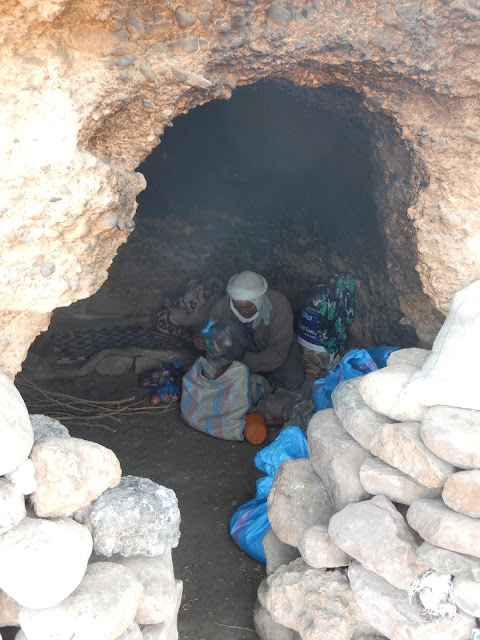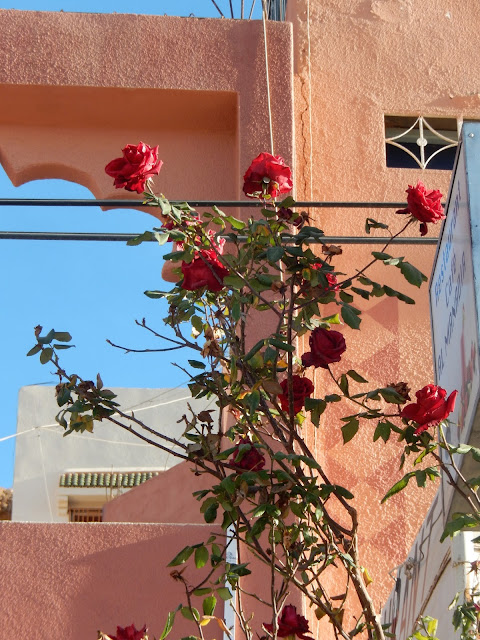 |
| Mountains, arid land, and Berber villages–that is Morocco |
During the final week of January, NJC provides staff and students with a week off. Many parents come over to Switzerland to join their daughters or sons in Zermatt for a week of skiing and other winter activities, but, since I do not ski, I was not interested in this trip. Instead, I wanted to do something completely different.
Fortunately, retired friends, Susan, Regan and Ruth, agreed to join me for a week in Morocco. This was a very exciting adventure for all of us, as it brought us to a continent and a country with which we had almost no familiarity. Only Ruth had previously set foot in Africa, and that was only for a few hours on a cruise.
 |
| We arrive in Marrakech |
We had chosen a Canadian/Moroccan company called Morocco Explored to arrange our week's visit for us. They came highly recommended on Trip Advisor, and through my colleague, Terry, who travelled with them in November. Morocco Explored took care of all the details for us; all we needed to do was make our way to Marrakech.
 |
| Faisal pours us our first mint tea to welcome us to Riad Dar Attika |
Our driver, Essalah, (whom we called Salah) met us at the airport and drove us into the heart of the old city–the medina–where we were housed in Riad Dar Attika. Like other such small hotels, our riad had a very plain exterior, but was well appointed inside. During our week in the country, we spent four comfortable nights there.
 |
| Moroccan salad dishes are very flavourful. |
That evening, we had our first taste of Moroccan food when we dined on salad and lamb couscous at The Bahia Palace Restaurant near our riad. It was also the first of many occasions where we found ourselves the only patrons at a hotel or a restaurant. Unfortunately, fear of terrorism has resulted in a drop of tourism in Morocco, and this was compounded by the fact that January is low season.
 |
| At the foothills of the Atlas Mountains |
The next morning, we were ready to go at 8:00 a.m. Salah loaded our luggage into a van and we were off on a four day excursion across the country. Our days of driving were long ones, but we saw spectacular sights along the way, as we traversed the High Atlas Mountains, twisting and turning on winding roads. Since we had the car and the driver to ourselves, we were free to request stops when we needed them, and to pepper Salah with questions..
 |
| Women work on the production of Argan Oil. |
Our first lengthy break occurred at a place where Berber women work to produce Argan oil products. This uniquely Moroccan export can be used to make hair shinier and skin healthier; it can relieve arthritis pain or be used as a cooking oil, as well as a substitute for peanut butter. Of course, we all came away with a few products.
 |
| A Berber village in the Atlas Muntains |
 |
| The many layers of the mountains |
From there, we continued to wend our way along mountain roads. We saw red rock, grey rock and brown rock, but it was all rock. Most of Morocco is desert, a landscape at times reminiscent of Arizona. The land is occasionally dotted with cacti, which only adds to its stark beauty.
 |
| The view down from the highest point. |
Eventually, we arrived at the highest point on the road (2 260 metres) via the Tizi N'Tichka pass, and looked down over the route that we had just taken.
 |
| Scenes from Ouarzazate |
Not long afterwards, we stopped for lunch in Ouarzazate, the Hollywood of Morocco. Here, in this desert city, movies such as Lawrence of Arabia and Game of Thrones were filmed. The city clearly takes great pride it its film industry as the islands at roundabouts are adorned with symbols of the industry. Clearly, the town's economy has been boosted as well; Ouarzazate was the most prosperous city we visited.
 |
| Caves are hidden in this rocky outcrop of land. |
Our route flattened out somewhat on the next leg of our journey. Salah proudly told us of the Berber people who form the majority in Morocco and whose villages dot the landscape in the region we were traversing. Traditionally farmers (as Salah's father was), some of them still lead a nomadic lifestyle, living in tents in the summer and caves in the winter.
 |
| Nomad in his cave dwelling. |
Suddenly, to our surprise, Salah took the van off-road. A half-kilometre or so away, we stopped at an open expanse of land where we saw a few goats grazing. Nearby, a nomad sat in a small cave. He let me take his picture.
 |
| Caves and goats |
A little later, we stopped at the Valley of Roses, where wild Damask roses are a major source of income for local people. In January, there were very few flowers in bloom, and the Asif M'Goun River was merely a trickle. (There has been a major drought in Morocco this year.)
 |
| A few roses in bloom |
 |
| The Valley of Roses |
Continuing east, we came upon another town, Boumaine Dades. Here, we stopped only long enough to take pictures in the late afternoon sunlight.
 |
| Boumaine Dades |
 |
| Our first Moroccan sunset, outside Tinghir. |
It was after sunset when we arrived at our destination, Tinghir. Again we had the hotel to ourselves, the Hotel Tomboctou, an establishment with African art in its common area, and a very colourful tent as a dining room. That evening, we tried pastilla, a traditional dish usually made with pigeon, but, in this case, it was filled with chicken.
 |
| Coy Ruth in the dining tent |
 |
| Pastilla: pastry topped with cinnamon wrapped around chicken. |
Having spent about eight hours in a car on the first day of our travels, we were pleased to start the second with a walking tour of Tinghir. Our local guide, Mohamed, met us at the hotel at 8:00 a.m. and led us to the "palmeraie", a fertile area outside the town walls. Besides harbouring palm trees, this area is used as a communal garden. Families work their own plots of land.
 |
| We enter the palmeraie |
 |
| Mohamed helps Sue across a log. |
This was a delightful stroll, where we learned about agricultural–and cultural–practices of the local people. We had to cross water three times, but Mohamed always lent us a secure hand to hold; he was a fount of information, too. And he gave shoulder massages to each of us.
 |
| Sue gets a shoulder massage. |
 |
| A local man working the land |
The pictures tell the story of this area of greenery in such a dry country. Eventually, our circular route took us back to an entrance into the city through a narrow passage. Mohamed led us to a cooperative where local women weave Berber carpets Over a glass of mint tea, we were given a demonstration of their practices and then, we were led to view many kinds and sizes of carpets. Of course, we all found something to bring home.
 |
| We enter the city. |
 |
| Examining Berber carpets. |
Shortly afterwards, we met Salah in the medina of Tinghir. He took us on a short side trip to the Todgha Gorge, a canyon a few kilometres north of us. On the way, we pulled over to the side of the road to look back over the city. So many palm tress!
 |
| A view back over the palms towards Tinghir |
The trip to the gorge was worthwhile even though it was very short. It is a popular place with local rock climbers and quite lovely. From there, we began the final leg of our journey.
 |
| The Todgha Gorge |
Our trip eastward lasted another three hours. We left the High Atlas Mountains behind, replacing them with the Anti Atlas range to the south, older hills formed of volcanic rock. Fossils are common in this part of the country so we made a stop at a factory that carved these natural wonders into household items. This time we resisted the pressure to buy,
 |
| Fossilized marble pieces: these are about four feet in height. |
 |
| Suddenly, there are sand dunes. |
Finally, the Sahara Desert emerged as a pink frothy confection on the horizon. It seemed so otherworldly, that it could have been a mirage. We had arrived at the easternmost point of our road trip across the country. We stopped at the Yasmina Hotel in Merzouga for a Moroccan pizza lunch.
 |
| Salah, our driver, joined us for Moroccan pizza |
 |
| Flatbread stuffed with vegetables: Moroccan pizza |
Shortly afterward, we began the most exciting experience of our week in Morocco. I will save the telling of that for the next blog post.































No comments:
Post a Comment